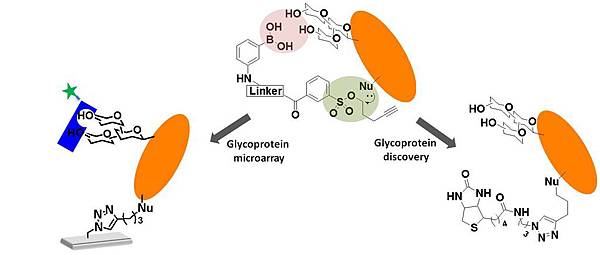Hi 大家好
此部落格已經暫停更新囉~
預知最新消息 煩請大家移至下列連結 http://pochiaolab.wixsite.com/pochiao
謝謝大家~
 NEW WEBSITE
NEW WEBSITEHi 大家好
此部落格已經暫停更新囉~
預知最新消息 煩請大家移至下列連結 http://pochiaolab.wixsite.com/pochiao
謝謝大家~
 最新消息-近期會議
最新消息-近期會議(1) 陳英瑜同學榮獲ACP獎勵參加會議並演講
Ying-Yu Chen won awards to attend the meeting and lecture in ACP conference.
(2)Basker 和 周志鴻同學受科技部獎勵至新加坡參加Tetrahedron
Basker and Chih-Hong Chou incentive to participate Tetrahedron conference in Singapore by the Ministry of Science and Technology.
(3)LPC 受邀參加2015 Tetashina conference, 並至京都大學演講
Po-Chiao Lin is invited to attend the Tetashina conference (2015),and lecture in Kyoto University.
 恭賀LPC榮獲102學年度年輕學者獎暨103學年度特聘年輕學者
恭賀LPC榮獲102學年度年輕學者獎暨103學年度特聘年輕學者

恭喜老闆Po-Chiao Lin(LPC)榮獲102學年度年輕學者獎暨103學年度特聘年輕學者
遲來的生日禮物&教師節禮物~~老師生日快樂&教師節快樂!!!
LPC said:
Thanks all you guys in LPC group! Let's dream all incredibly crazy but amizing chemistry all the time. Probably someday we can guide cell tells us what happens inside it!
呼,我們實驗室總算有受到一點小小的肯定!不過離目標還早呢,繼續加油吧!LPCs, go go go!
 最新發表: 有效的利用金屬Cu/Rh催化一鍋化合成環狀Indol衍生物
最新發表: 有效的利用金屬Cu/Rh催化一鍋化合成環狀Indol衍生物本實驗室於2014年最新研究成果發表於美國化學會有機化學期刊 Organic Letters
利用銅(Cu)金屬催化形成triazole之產物,再進一步一鍋化利用銠(Rh)金屬催化合環形成吲哚(Indole)之衍生物
後續之合成應用亦正在積極開發中!

ABSTRACT: An efficient Cu/Rh-catalyzed method is proposed for the synthesis of 3-indolylimines from N-propargylanilines through Rh(II)-catalyzed denitrogenative annulation of N-sulfonyl-1,2,3-triazoles. Further combined with hydrolysis or reduction, a one-pot method is developed to enable the direct incorporation of an imine, aldehyde, or amine group into an indole system from an alkyne. A variety of substituted 3-indolylimines, indole-3-carboxaldehydes, and 3-Indolylmethanamines are synthesized in good yields.
本研究發表於
 最新發表: 無殘留式醣蛋白探針之開發及其在醣蛋白晶片之應用
最新發表: 無殘留式醣蛋白探針之開發及其在醣蛋白晶片之應用本實驗室成功開發極具重要性之無殘留式醣蛋白專一性化學探針。並成功應用於醣蛋白晶片之研究。
此研究成果發表於聲譽卓著之美國化學會化學生物學期刊 (ACS Chem. Biol. 2014, 9, 390.)
http://pubs.acs.org/doi/abs/10.1021/cb400631w

ABSTRACT: A new chemical method for the traceless labeling of glycoproteins with synthetic boronic acid (BA)-tosyl probes was successfully developed. The BA moiety acts as an affinity head to direct the formation of a cyclic boronate diester with the diol groups of glycans. Following this step, the electrophilic tosyl group is displaced by an SN2 reaction with a nucleophilic residue of the boronated glycoprotein, and finally, a reporter group is tagged onto the glycoprotein via an ether linkage. In the presence of polyols, a competition reaction recovers the native glycan of the tagged glycoprotein, conserving its biological significance. The BA-tosyl probes were used successfully for the specific labeling of glycosylated fetuins in a mixed protein pool and from crude Escherichia coli (E. coli) lysate. Further, a BA-tosyl–functionalized glass slide was used to fabricate glycoprotein microarrays with highly conserved glycans. By interacting with various lectins (carbohydrate-binding proteins), such as Concanavalin A (Con A) and wheat germ agglutinin (WGA), the types of carbohydrates and specific linkages of glycoproteins (α or β) could be systematically monitored. It is believed that the newly developed method will greatly accelerate the understanding of glycoproteins.